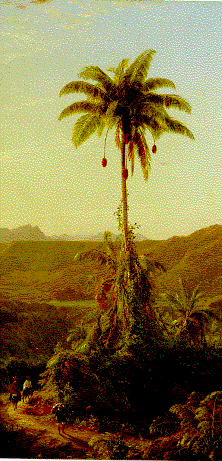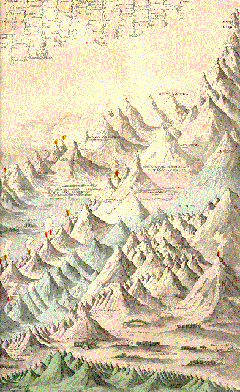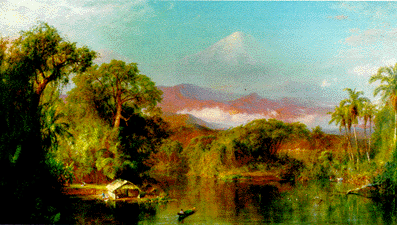
 During the period of Spanish and Portuguese colonial rule in Central and South America, the empire was all but closed off to outsiders, spawning larger-than-life legends about the fantastic riches of the South. European travelers in the 15th and 16th centuries were already prone to imagine that the Americas contained mythical beasts and monsters, as well as cities of gold. The Incan Empire's stores of gold, which Pizarro ransacked, only reinforced such fantastical thinking, and much of the effort of the colonial administration was devoted to labor-intensive (and environmentally catastrophic) mining of gold, silver, and gemstones. The New England historian William Prescott devoted years to researching and writing his companion volumes, The Conquest of Mexico (1843) and The Conquest of Peru (1847). These works were hugely popular during the period- among other reasons, because they portrayed early, indigenous American empires in a relatively positive light, and at the expense of the imperial Spaniards. During the period of Spanish and Portuguese colonial rule in Central and South America, the empire was all but closed off to outsiders, spawning larger-than-life legends about the fantastic riches of the South. European travelers in the 15th and 16th centuries were already prone to imagine that the Americas contained mythical beasts and monsters, as well as cities of gold. The Incan Empire's stores of gold, which Pizarro ransacked, only reinforced such fantastical thinking, and much of the effort of the colonial administration was devoted to labor-intensive (and environmentally catastrophic) mining of gold, silver, and gemstones. The New England historian William Prescott devoted years to researching and writing his companion volumes, The Conquest of Mexico (1843) and The Conquest of Peru (1847). These works were hugely popular during the period- among other reasons, because they portrayed early, indigenous American empires in a relatively positive light, and at the expense of the imperial Spaniards.
Some of Dickinson's frequent references to South America indirectly recall these legendary tales of wealth, as in this love poem:
Your Riches- taught me Poverty,
Myself - a Millionaire
In little Wealths, as Girls could boast
Till broad as Buenos Ayre-
You drifted your Dominions-
A Different Peru-
And I esteemed All Poverty
For Life's Estate with you-
[Johnson 299]
She often summons such images of worldly riches (one of her favorite images is the "Pearl") to contrast them with something more truly valuable: the commitment of the "you" in the poem above, or the natural world in 697, another work laden with images from a legendary, mythic view of South America and its riches:
I could bring You Jewels- had I a mind to-
But You have enough- of those-
I could bring You Odors from St. Domingo-
Colors-from Vera Cruz-
Berries of the Bahamas-have I-
But this little Blaze
Flickering to itself-in the Meadow-
Suits Me-more than those-
Never a Fellow matched this Topaz-
And his Emerald Swing-
Dower itself- for Bobadilo-
Better-Could I bring?
 Aside from Prescott's histories, another major source of information about South America during this period was scientific and visual. During the 1810s, Alexander von Humboldt became one the first Europeans to travel into the interior of Spanish America. A towering intellectual figure during the nineteenth century, Humboldt formulated a new theory of the cosmos based on his observations of the great biological and geological diversity he found in the Americas. (His theory would influence Whitman's use of the Greek term kosmos.)
Aside from Prescott's histories, another major source of information about South America during this period was scientific and visual. During the 1810s, Alexander von Humboldt became one the first Europeans to travel into the interior of Spanish America. A towering intellectual figure during the nineteenth century, Humboldt formulated a new theory of the cosmos based on his observations of the great biological and geological diversity he found in the Americas. (His theory would influence Whitman's use of the Greek term kosmos.)
Volcanoes be in Sicily
And South America
I judge from my Geography-
Volcanoes nearer here
A Lava step at any time
Am I inclined to climb-
A Crater I may contemplate
Vesuvius at Home.
 Frederick Edwin Church, an American landscape painter, followed Humboldt's footsteps to Ecuador, Venezuela, Colombia, Mexico, and the Caribbean, producing enormous, luminous canvases filled with precise botanical details that created a sensation when they were exhibited in the U.S. There was considerable geographical debate on whether Mt. Chimborazo was the highest point in the hemisphere (it is not, but only because of differences in the depth of the earth's surface), and the question of Chimborazo's height enters into another love poem: Frederick Edwin Church, an American landscape painter, followed Humboldt's footsteps to Ecuador, Venezuela, Colombia, Mexico, and the Caribbean, producing enormous, luminous canvases filled with precise botanical details that created a sensation when they were exhibited in the U.S. There was considerable geographical debate on whether Mt. Chimborazo was the highest point in the hemisphere (it is not, but only because of differences in the depth of the earth's surface), and the question of Chimborazo's height enters into another love poem:
Love-thou art high-
I cannot climb thee-
But, were it Two-
Who knows but we-
Taking turns-at the Chimborazo-
Ducal-at last-stand up by thee-
The vividness of tropical colors, and the intensity of the tropical climate, are particularly suggestive for Dickinson. The extremes of climate that Dickinson associates with "the south" and "the tropics" are embodied in the image of the volcano, which she frequently employs. Like Church’s brightly colored canvases, they resonate with U.S. audiences in part because of their strong contrast with "our" America:
Conjecturing a Climate
Of unsuspended Suns-
Adds poignancy to Winter-
The Shivering Fancy turns
To a fictitious Country
To palliate a Cold-
Not obviated of Degree-
Nor eased- of Latitude- [Johnson 562]
 
|





